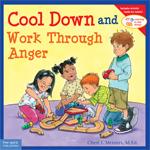Teaching Children to Cool Down and Work Through Anger
By Cheri J. Meiners, M.Ed., author of the Learning to Get Along® and Being the Best Me! series

Cheri Meiners
Children, like all of us, are frequently bombarded with situations that are unexpected, frustrating, or hurtful. Anger is a natural secondary emotion when children feel out of control. They may feel threatened when their belongings or personal space is being invaded, when they are not being respected, when they can’t have something they want, or when things just aren’t going the way they would like. As teachers and parents, we can help children work through anger appropriately by teaching them to recognize, defuse, process, and resolve their angry feelings.
Help Children Recognize Anger In quiet moments, children can be taught to become aware of the physical changes they feel when they start to feel angry. Explain that it’s normal for people to experience an increased heart rate or breathing, or an urge to speak loudly or lash out physically. Though natural, it is, of course, important for children to understand that hurting themselves or someone else or damaging property are not acceptable or tolerable displays of their anger. Talk with them about situations that might trigger their anger to help them become aware of their own natural responses.
Help Children Defuse Anger Children can be taught ways to calm themselves and defuse their anger. When they relax physically and mentally, children can create some space between the stimulus that annoyed them and their response. Children may then process and respond to the problem logically and rationally rather than in ways they may regret later. There are many techniques you might suggest to children. Some favorites that require no materials or location are:
- Count to ten.
- Take big breaths as if filling a balloon.
- Walk away until you feel calm.
- Sing a favorite song to yourself.
- Think about a happy time.
- Talk to an adult.
Help Children Resolve Anger A more difficult and often overlooked part of teaching kids about anger is helping them learn to process their anger by discovering what triggered it, and helping them develop skills to work through the problem—or decide to let it go. Here are a few ideas:
1. Be an example to your child. Remain calm yourself when a child acts out. Remember your own struggles and the vulnerabilities you felt as a child. With that empathy, respect children’s feelings, and give them space to comply without forcing them. Take time to listen before disciplining. Your calm example and listening ear can strengthen the trust they feel in you, and help them feel confident in coming to you when working through their problems.
2. Teach children to accept things they can’t change. Children may be frustrated by their own limitations or rules they are asked to follow. For those things that can’t be changed, help children understand why things are as they are, and then help them find something else to focus on so they can let it go.
3. Practice good communication skills. Talking and listening to other children can also help children resolve differences. Practice these skills together through role play and discussion, such as at mealtime. Teach children how to apologize and accept apologies. Although it isn’t easy, learning to consider the viewpoints of others will help them respect others and empathize with them, which can help dissipate anger.
4. Help children view the situation in a new way. Because our emotions are tied to our thoughts, it’s possible to change the way we feel by changing the way we view a problem. Finding positive ways to look at situations is an essential skill to happiness and to getting along with others.
5. Let children know that they have control over their emotions. Connected to the idea that we can change our thoughts is the understanding that we can decide to be happy by choosing our own thoughts and actions . Let children know that they are not victims of other people’s decisions and actions. Even when children are faced with situations beyond their control, they can choose how they will respond to the situation. Sometimes they may decide to accept something and move on. At other times, the child may find a way to talk with the person or do something that can make things better.
. Let children know that they are not victims of other people’s decisions and actions. Even when children are faced with situations beyond their control, they can choose how they will respond to the situation. Sometimes they may decide to accept something and move on. At other times, the child may find a way to talk with the person or do something that can make things better.
 . Let children know that they are not victims of other people’s decisions and actions. Even when children are faced with situations beyond their control, they can choose how they will respond to the situation. Sometimes they may decide to accept something and move on. At other times, the child may find a way to talk with the person or do something that can make things better.
. Let children know that they are not victims of other people’s decisions and actions. Even when children are faced with situations beyond their control, they can choose how they will respond to the situation. Sometimes they may decide to accept something and move on. At other times, the child may find a way to talk with the person or do something that can make things better.
At all times, let children know that you are their advocate—that you believe in them and want them to be happy. Help them understand that having strong feelings such as anger is natural, and that they can learn to recognize, defuse, and process that energy in positive ways to address problems, understand someone else better, and feel happier.
What are some ways you help kids cope with angry feelings?


